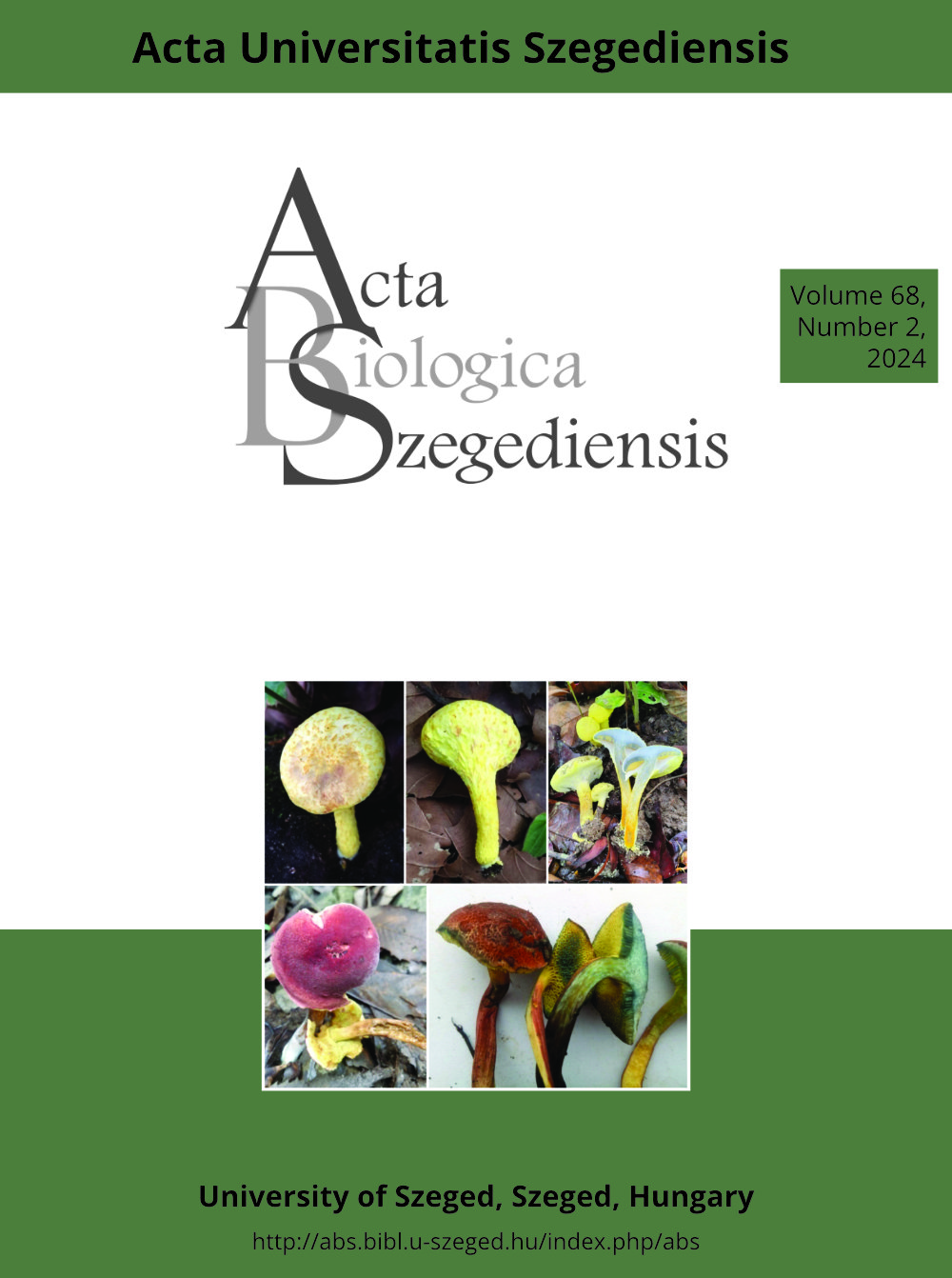Mucoromycota tannases
activity screening, production and enzyme purification
DOI:
https://doi.org/10.14232/abs.2024.2.68-78Keywords:
anion exchange chromatography, enzyme activity screening, submerged and solid-state fermentations, tannase, wheat bran, zygomycetesAbstract
Tannases are industrial enzymes that catalyze the degradation of hydrolysable and complex tannins into gallic acid and glucose. While many filamentous fungi are known high-yield producers, members of Mucoromycota remain less studied regarding tannase production. This study screened Mucoromycota isolates for tannase production using plate tests with tannic acid as an enzyme production inducer. Isolates of Rhizomucor miehei, Mucor corticolus, Mucor lusitanicus, Rhizopus microsporus var. oligosporus, and Rhizopus oryzae exhibited tolerance to the inducer, with tannase production detected in most strains post-incubation. Tannic acid effectively induced tannase production under both submerged fermentation (SmF) and solid-state fermentation (SSF) conditions. In SSF, wheat bran as a substrate and Czapek-Dox solution as a moisturizing additive supported enzyme production. The highest tannase activity in SSF was observed in R. microsporus var. oligosporus and M. corticolus, while R. miehei excelled under SmF conditions. Tris buffer extraction followed by anion exchange chromatography yielded tannase-active protein fractions from M. corticolus. The isolated tannase exhibited optimal activity at 30 °C. These findings highlight Mucoromycota fungi as promising tannase producers for future research.
Downloads
References
Abd-Elmotey S, Nasar FR, Nasar SA, Abou-Taleb KA (2022) Tannase and gallic acid production by Aspergillus nigerSWP33 and Penicillium griseoroseum T11 using agricultural wastes under submerged and solid-state fermentation and its application. Egypt J Chem 65:21-35.
Aguilar CN, Favela-Torres E, Viniegra-González G, Augur C (2002) Culture conditions dictate protease and tannase production in submerged and solid-state cultures of Aspergillus niger Aa-20. Appl Biochem Biotechnol 102-103:4 07- 414 .
Aguilar CN, Gutiérrez-Sánchez G (2001) Review: Sources, properties, applications and potential uses of tannin acyl hydrolase. Food Sci Tech Int 7:373-382.
Aguilar CN, Rodríguez R, Gutiérrez-Sánchez G, Augur C, Favela-Torres E, Prado-Barragán LA, Ramírez-Coronel A, Contreras-Esquivel JC (2007) Microbial tannases: advances and perspectives. Appl Microbiol Biotechnol 76:47-59.
Aharwar A, Parihar DK (2018) Tannases: production, proper-ties, applications. Biocatal Agric Biotechnol 15:322-334.
Aissam H, Errachidi F, Penninckx MJ, Merzouki M, Benlemlih M (2005) Production of tannase by Aspergillus niger HA37 growing on tannic acid and olive mill waste waters. World J Microbiol Biotechnol 21:609-614.
Andrade PML, Baptista L, Bezerra CO, Peralta RM, Góes-Neto A, Uetanabaro APT, Costa AMD (2021) Immobilization and characterization of tannase from Penicillium rolfsii CCMB 714 and its efficiency in apple juice clari-fication. J Food Meas Charact 15:1005-1013.
Banerjee D, Mondal KC, Pati BR (2001) Production and characterization of extracellular and intracellular tannase from newly isolated Aspergillus aculeatus DBF 9. J Basic Microbiol 41:313-318.
Banerjee D, Mondal KC, Pati BR (2007) Tannase production by Aspergillus aculeatus DBF9 through solid-state fermentation. Acta Microbiol Immunol Hung 54:159-166.
Bradoo S, Gupta R, Saxena RK (1996) Screening of extracellular tannase-producing fungi: development of a rapid and simple plate assay. J Gen Appl Microbiol 42:325-329.
Bradoo S, Gupta R, Saxena RK (1997) Parametric optimization and biochemical regulation of extracellular tannase from Aspergillus japonicus. Process Biochem 32:135-139.
Chatterjee R, Dutta A, Banerjee R, Bhattacharyya BC (1996) Production of tannase by solid-state fermentation. Bio-process Eng 14:159-162.
Chávez-González M, Rodríguez-Durán LV, Balagurusamy N, Prado-Barragán A, Rodríguez R, Contreras JC, Aguilar CN (2012) Biotechnological advances and challenges of tannase: an overview. Food Bioprocess Technol 5:445-459.
Cruz-Hernández M, Augur C, Rodríguez R, Contreras-Esquivel JC, Aguilar CN (2006) Evaluation of culture conditions for tannase production by Aspergillus nigerGH1. Food Technol Biotechnol 44:541-544.
Das Mohapatra PK, Biswas I, Mondal KC, Pati BR (2020) Concomitant yield optimization of tannase and gallic acid by Bacillus licheniformis KBR6 through submerged fermentation: An industrial approach. Acta Biol Szeged 6 4:151-158 .
El-Refai HA, Abdel-Naby MA, Mostafa H, Amin MA, Salem HAA (2017) Statistical optimization for tannase production by Mucor circinelloides isolate F6-3-12 under submerged and solid state fermentation. Curr Trends Biotech nol Pharm 11:167-180.
Farhaan MM, Patil RC (2019) Screening and characterisation of tannase producing fungi from soil near tannery industry. European J Biotechnol Biosci 7:68-70.
Hadi TA, Banerjee R, Bhattacharyya BC (1994) Optimization of tannase biosynthesis by a newly isolated Rhizopus oryzae. Bioprocess Eng 11:239-243.
Hota SK, Dutta JR, Banerjee R (2007) Immobilization of tannase from Rhizopus oryzae and its efficiency to pro-duce gallic acid from tannin rich agro-residues. Indian J Biotechnol 6:200-204.
Jana A, Halder SK, Ghosh K, Paul T, Vágvölgyi C, Mondal KC, Das Mohapatra PK (2015) Tannase immobilization by chitin-alginate based adsorption-entrapment technique and its exploitation in fruit juice clarification. Food Bioprocess Technol 8:2319-2329.
Jana A, Maity C, Halder SK, Mondal KC, Pati BR, Das Mohapatra PK (2012) Tannase production by Penicil-lium purpurogenum PAF6 in solid state fermentation of tannin-rich plant residues following OVAT and RSM. Appl. Biochem Biotechnol 167:1254-1269.
Kasieczka-Burnecka M, Kuc K, Kalinowska H, Knap M, Turkiewicz M (2007) Purification and characterization of two cold-adapted extracellular tannin acyl hydrolases from an Antarctic strain Verticillium sp. P9. Appl Microbiol Biotechnol 77:77-89.
Kumar SS, Sreekumar R, Sabu A (2019) Tannase and its applications in food processing. In Parameswaran B, Varjani S, Raveendran S, eds., Green Bio-processes. Enzymes in Industrial Food Processing. Springer, Singapore , 357-381.
Londoño-Hernández L, Ramírez-Toro C, Ruiz HA, Ascacio-Valdés JA, Aguilar-Gonzalez MA, Rodríguez-Herrera R, Aguilar CN (2017) Rhizopus oryzae – Ancient microbial resource with importance in modern food industry. Int J Food Microbiol 257:110-127.
Lopes LMDM, Batista LHC, Gouveia MJ, Leite TCC, de Mello MRF, de Assis SA, de Sena AR (2018) Kinetic and thermodynamic parameters, and partial characterization of the crude extract of tannase produced by Saccharomyces cerevisiae CCMB 520. Nat Prod Res 32:1068-1075.
Meini M-R, Cabezudo I, Galetto CS, Romanini D (2021) Production of grape pomace extracts with enhanced antioxidant and prebiotic activities through solid-state fermentation by Aspergillus niger and Aspergillus oryzae. Food Biosci 42:101168.
Mostafa HS (2023) Potato peels for tannase production from Penicillium commune HS2, a high tannin-tolerant strain, and its optimization using response surface methodology. Biomass Conv Bioref 13:16765-16778.
Mukherjee G, Banerjee R (2004) Biosynthesis of tannase and gallic acid from tannin rich substrates by Rhizopus oryzae and Aspergillus foetidus. J Basic Microbiol 44:42-48.
Omotayo MA, Olaleye ON, Odetunde SK, Avungbeto MO (2023) Isolation and molecular identification of tannase producing fungi from soil. Afr J Biotechnol 22:322-328.
Ong CB, Annuar MSM (2024) Potentialities of tannase-treated green tea extract in nutraceutical and therapeutic applications. Appl Biochem Biotechnol 196:7534-7553.
Papadaki E, Mantzouridou FT (2024) Application of Aspergillus niger for extracellular tannase and gallic acid produc-tion in non-sterile table olive processing wastewaters. Waste Biomass Valor 15:1199-1212.
Papp T, Nyilasi I, Csernetics Á, Nagy G, Takó M, Vágvölgyi C (2016) Improvement of industrially relevant biological activities in Mucoromycotina fungi. In Schmoll M, Dattenböck C, eds., Gene Expression Systems in Fungi: Ad-vancements and Applications. Fungal Biology. Springer, Cham, 97-118 .
Prigione V, Spina F, Tigini V, Giovando S, Varese GC (2018) Biotransformation of industrial tannins by filamentous fungi. Appl Microbiol Biotechnol 102:10361-10375.
Qiu Y, Niu H, Huang W, He Y, Wu XH (2011) Properties and secondary structure of tannase from Penicillium herquei. Biotechnol Bioprocess Eng 16:858-866.
Ramírez-Coronel MA, González GV, Darvill A, Augur C (2003) A novel tannase from Aspergillus niger with β-glucosidase activity. Microbiology 149:2941-2946.
Ramli MS, Siva R, Rashid NYA, Sharifuddin SA, Samat N, Hasibuan S, Lani MN, Mansor A (2021) Screening of potential tannase-producing fungi from local agri-industrial by-products using a plate assay and submerged fermentation. Int J Adv Sci Eng Inf Techno 11:1209-1213.
Renovato J, Gutiérrez-Sánchez G, Rodríguez-Durán LV, Bergman C, Rodríguez R, Aguilar CN (2011) Differential properties of Aspergillus niger tannase produced under solid-state and submerged fermentations. Appl Biochem Biotechnol 165:382-395.
Shao Y, Zhang YH, Zhang F, Yang QM, Weng HF, Xiao Q, Xiao AF (2020) Thermostable tannase from Aspergillus niger and its application in the enzymatic extraction of green tea. Molecules 25:952.
Sharma S, Bhat TK, Dawra RK (2000) A spectrophotometric method for assay of tannase using rhodanine. Anal Biochem 279:85-89.
Takó M, Kotogán A, Krisch J, Vágvölgyi C, Mondal KC, Papp T (2015) Enhanced production of industrial enzymes in Mucoromycotina fungi during solid-state fermentation of agricultural wastes/by-products. Acta Biol Hung 66:348-360.
Van Diepeningen AD, Debets AJM, Varga J, Van Der Gaag M, Swart K, Hoekstra RF (2004) Efficient degradation of tannic acid by black Aspergillus species. Mycol Res 108:919-925.
Vattem DA, Shetty K (2002) Solid-state production of phenolic antioxidants from cranberry pomace by Rhizopus oligosporus. Food Biotechnol 16:189-210.
Wakil SM, Ajayi OD, Fasiku SA (2020) Production of tannase by fungi isolated from different soils. J Basic Appl Sci 16:1-8.
Yao J, Guo GS, Ren GH, Liu YH (2014) Production, characterization and applications of tannase. J Mol Catal B Enzym 101:137-147.
Downloads
Published
How to Cite
Issue
Section
Funding data
-
Nemzeti Kutatási Fejlesztési és Innovációs Hivatal
Grant numbers FK 134886;TKP2021-EGA-28 -
Magyar Tudományos Akadémia
Grant numbers HUN-REN 2001007








